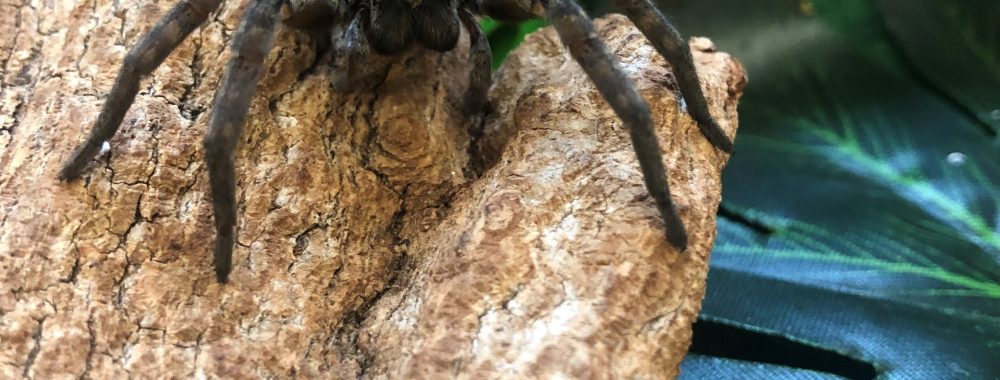Luna
Fast Facts
- Class: Arachnida
- Order: Araneae
- Family: Lycosidae (from ancient Greek for “wolf”)

Lifespan
Typically 1 year or less, though females can live for several years
Natural Habitat
Broad range throughout the globe, they have adapted to extremely varied climates from cold rocky mountain tops to volcanic lava tubes. They inhabit rainforests as well as deserts, and are even found in suburban lawns and gardens.
Features
Ranging in size from ¼ inch to 1.4 inches body size (not including legs), there are thousands of species of Wolf Spider. Most do not spin webs, but rather pursue their prey by chasing and then pouncing on them (like wolves). They are incredibly agile and fast. Once they have caught their prey they can inject venom with their fangs liquefying the organs to then suck up; or they can also mash up the prey mechanically into small enough bits to ingest. Wolf spiders have excellent eyesight with EIGHT eyes: 2 large ones on the top of the head (cephalothorax), 2 large ones on the front of the head, and 4 smaller eyes in a horizontal row just above the mouth. They are mostly ground dwelling and have dark brown to black mottled coloring which serves as excellent camouflage amidst soil and decayed plant matter. Some species dig burrows, while others live under rocks or within logs. As with most species of spiders in general, males can sometimes be found within homes and other buildings as they wander in search of females during the autumn.
Thus, Luna here, is probably a male. He was brought in to The Science Zone in the fall of 2021 by a concerned good Samaritan who had mistaken him for a tarantula (understandably) and rescued him from a friend’s basement!
Diet
Insectivore, opportunistic predator; Luna is fed a variety of insects including crickets, dubia roaches and mealworms.
Conservation
Most species of Wolf Spider populations are stable, however some are endangered including the desertas wolf spider of Portugal and the Kaua’i cave spider of Hawaii. Wolf spiders play an important role in the natural population control of insects. They are also beneficial directly to humans due to their predation of insect species that are considered pests within farms and gardens. Thus, as the saying goes, like the good humans who brought Luna to us, “Be nice to Mr. Spider”. They may look scary, but these guys are good to keep around!
Once Luna was identified as a wolf spider, which are native here in Wyoming, and deemed to be in good enough health to release (he was initially stressed, dehydrated and HUNGRY!), snow fell hard; so the decision was made to keep him here until spring, serving as an ambassador for his family of wolf spiders around the globe.
Fun Facts
- After mating the females lay 100 or more eggs which are encased in a silk sac, and unlike other species of spiders, she then attaches and carries the sac around with her on her spinnerets at the end of her abdomen.
- Unique only to wolf spiders, when the spiderlings hatch, they climb up their mother’s legs and onto her back where she continues to protect and carry them (for several weeks) until they are ready to survive on their own!
- Females sometimes kill and eat males after mating!
- Wolf spider venom is not lethal or toxic to humans and rarely do bites elicit an allergic reaction. Furthermore, Wolf spiders are typically not aggressive, but will bite defensively if captured and feel threatened. Their bite typically feels like a bee sting.
- The four larger eyes of the wolf spider have reflective tissue within the retina called the tapetum lucidum which produces “eyeshine”: it reflects back light that is directed toward it, producing a noticeable glow. A variety of other animals, especially nocturnal creatures, also have this specialized tissue in their eyes. You may have seen this “eyeshine” while driving at night when a stray cat (or other critter) stares back into the headlights.
- Wolf spiders have the third best eyesight of all spider species (after jumping spiders which can distinguish colors, and huntsman spiders).


We love meeting new people!